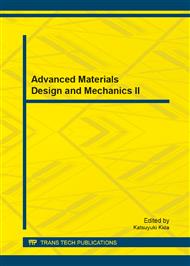[1]
R. H. J. Hannick, P. M. Kelly, B. C. Muddle, Transformation toughening in zirconia-containing ceramics, J. Am. Ceram. Soc. 83 (2000) 461-487.
Google Scholar
[2]
K. Obal, Z. Pedzich, T. Brylewski, M. Rekas, Modification of yttria-doped tetragonal zirconia polycrystal ceramics, Int. J. Electrochem. Sci. 7 (2012) 6831-6845.
Google Scholar
[3]
K. M. Patel, P. M. Pandey, P. V. Rao, Optimization of process parameters for multi-performance characteristics in EDM of Al2O3 ceramic composites, Int. J. Adv. Manuf. Tech. 47 (2010) 1137-1147.
DOI: 10.1007/s00170-009-2249-7
Google Scholar
[4]
ASTM E1876-97, Standard Test Method for Dynamic Young's Modulus, Shear Modulus and Poisson's Ratio by Impulse Excitation of Vibration, Annual Book of ASTM Standards (1998).
DOI: 10.1520/e1876-22
Google Scholar
[5]
K. Niihara, H. Morena, D. P. H. Hassleman, Evaluation of KIc of brittle solids by the indentation method with low crack to indent ratios, J. Mater. Sci. Lett. 1 (1982), 13-16.
DOI: 10.1007/bf00724706
Google Scholar
[6]
A. Muknopadhyay, B. Basu, S. Das Bakshi, S. K. Mishra, Pressureless sintering of ZrO2-ZrB2 composites: Microstructure and properties, Int. J. Refract. Met. Hard Mater. 25 (2007) 179-188.
DOI: 10.1016/j.ijrmhm.2006.04.006
Google Scholar
[7]
S. Das Bakshi, B. Basu, S. K. Mishra, Microstructure and mechanical properties of sinter-HIPed ZrO2-ZrB2 composites. Composites A. 37 (2006) 2218-2135.
DOI: 10.1016/j.compositesa.2005.11.012
Google Scholar
[8]
S. Postrach, J. Potschke, Pressureless Sintering of Al2O3 containing up to 20 vol% zirconium diboride (ZrB2), J. Eur. Ceram. Soc. 20 (2000) 1459-1468.
DOI: 10.1016/s0955-2219(00)00026-1
Google Scholar
[9]
D. P. F. De Souza, A. L. Chinelatto, Impure zirconia electrical conductivity enhancement by rare-earth minority ions in the Y2O3 RE2O3 ZrO2 system, J. Mater. Sci. 30 (1995) 4355-4362.
DOI: 10.1007/bf00361517
Google Scholar


